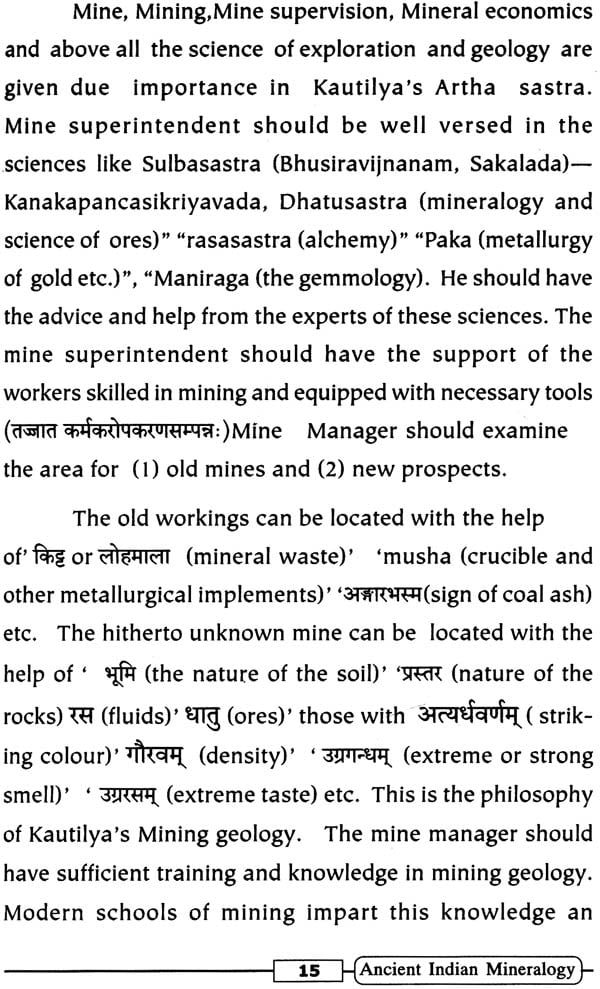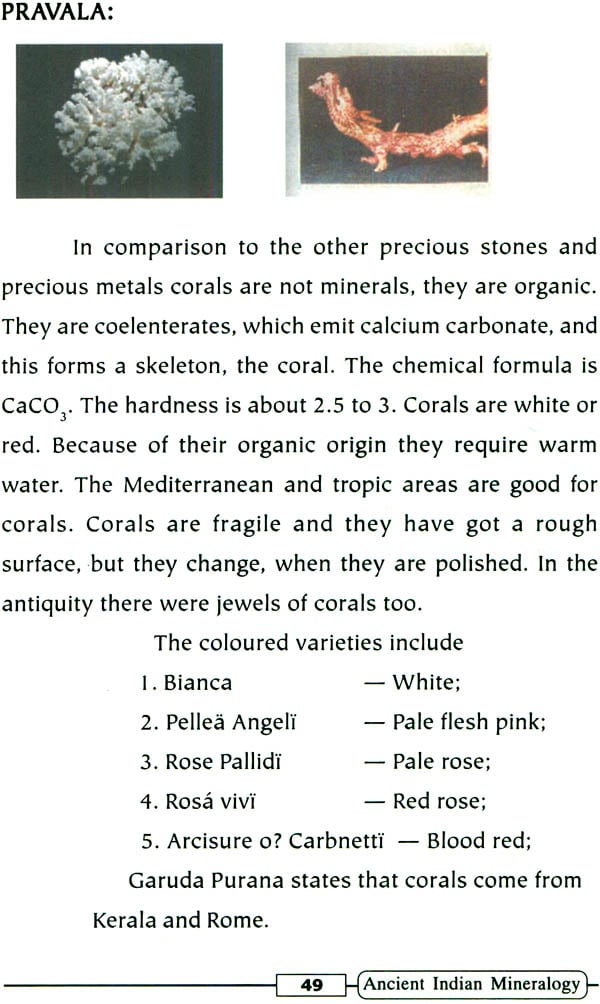
Mineralogical Traditions in Sanskrit Literature – Sanskrit-Science Series-8 (Ancient Indian Mineralogy- No: 1)
Book Specification
| Item Code: | NAC018 |
| Author: | Dr. Srinivas Madabhushi |
| Publisher: | Rashtriya Sanskrit Vidyapeetha, Tirupati |
| Language: | English |
| Edition: | 2004 |
| Pages: | 81 (12 Color Illustrations) |
| Cover: | Paperback |
| Other Details | 8.5 Inch X 5.5 Inch |
| Weight | 120 gm |
Book Description
About Sanskrit - Science Series....
All the regions of human society beyond geographical limitations accept that Sanskrit is the main spring of a grand series of scientific disciplines in the ancient world and in the Indian peninsular The disciplines like Mathematics, Physics, Chemistry, Botany, Metallurgy, Meteorology Management etc., have their clean traces back in the ancient Sanskrit literature. Hence emerged the new branch “Sanskrit - Science” with millennia’s strength as a result of the incessant efforts of modern knowledge seekers all over the world.
Knowledge of Sanskrit and perceptive analysts of scientific knowledge base presented by our Rishis and perceptive thinkers would be of great help in getting a good insight into our rich scientific heritage.
It is the responsibility of our institutions to arouse the interest of younger generations in sanskrit by unraveling the profound scientific wisdom that is contained in the Sanskrit literature by demonstrating its glory and relevance to the modern world. It is with this objective in view the Sanskrit - Science Study Centre of Rashtriya Sanskrit Vidyapeetha has taken initiative to launch a series of publication of small booklets which would cover a wide canvass of a foresaid discipline of Sanskrit - Science
It is now being increasingly recognized that ancient Sanskrit Literature contains profound wisdom of physical and social sciences. The scientific knowledge base presented by our Rishis and perceptive thinkers covers a wide canvas of subjects such as Physics, Chemistry, Mathematics, Astronomy, Metallurgy, Rio-Technology and Environmental Science etc.
Unfortunately, due to a very long period of intellectual domination of the forces from outside the region, we have lost our awareness about the profound contributions made by our ancestors that are hidden in the vast Sanskrit literature. Our continued apathy towards Sanskrit language over the recent centuries has also contributed to our lack of awareness about rich scientific heritage. Our ignorance about the richness of our heritage has made us to lose our sense of pride for what is ours. As a result of all this, our sense of confidence in our own capabilities has also been shaken.
Knowledge of Sanskrit and perceptive analysis of contents of our ancient Sanskrit literature would be of great help in getting a good insight into our rich scientific heritage It is the responsibility of Sanskrit institutions to arouse the interests of the modern world in Sanskrit by unraveling the profound scientific wisdom that is contained in the Sanskrit literature and by demonstrating its relevance to the modern world. It is only when a link between the Sanskrit world and the modern world is established that the acceptability of Sanskrit as a relevant subject for dealing with the contemporary challenges of life would be enhanced. It is with this object in view that the Rashtriya Sanskrit Vidyapeetha, Tirupati, launched a series of publication of small book-lets which cover wide canvass of subjects such as Physics, Chemistry, Astronomy and Ayurveda etc. for the enlightenment of younger generations of India.
Dr. Srinivas Madabhushi, who is profound scholar of Geology and Sanskrit, has prepare d this booklet with his vast experience of research in the subject. I congratulate him for preparing such a wonderful booklet.
I hope that this booklet would be found useful by students and scholars alike and inspire many students of Geology and Sanskrit.
Prof. D. Prahlada Char
Vice - Chancellor
We feel immensely happy and proud to present this small booklet entitled “Mineralogical Traditions in Sanskrit Literature” to the young readers who have a longing to have a glimpse of the wisdom of ancient India.
There is a general belief that contribution of ancient India is limited to the field of humanities particularly that of religion and phylosophy. Of course, no other civilization can claim superiority over what India has achieved in that area. Still if we go through the pages of this small booklet, we will realize that in the area of Astronomy India’s contribution was amazing. Now India has already lost much of its ancient lore due to the impact of foreign invasion. What remains also is largely unknown as most of it is in Sanskrit. Hence, we feel that there is an urgent need to save the remaining knowledge and build up awareness in all concerned especially among younger generations who are not aware of our ancient scientific heritage contained in Sanskrit.
Shouldering this responsibility i.e. creating the interests among the younger generations in Sanskrit by unraveling the profound scientific wisdom that is contained in the Sanskrit literature and demonstrating its relevance to the modern world, Rashtriya Sanskrit Vidyapeetha took the initiative of organising the Sanskrit Science exhibitions, publishing and propagating the scientific literature of Sanskrit through out India.
I should mention at the out set that the inspiration to publish such booklets came from our Hon’ble Chancellor Dr.V.R.Panchamukhi, Economist of International fame, and versatile scholar in Sanskrit.
I would like to express my sincere thanks to Dr. Srinivas Madabhushi, for preparing this wonderful booklet.
If this small booklet kindles a tiny flame of desire in the hearts of young readers for studying the store house of past glory of India, we feel we would have been rewarded for our efforts.
Dr. Srinivas Madabhushi did his B.Sc in 1970 with Sanskrit and stood first among his fellow students. He completed his MSc., (Tech) in Applied Geology from Andhra University in 1974 se curing a record of 79% of marks which fetched him the all tech first prize. He was awarded Ph.D in Geology on “Structure, Lithofacies, Sedimentary Tectonics and Coal potentialities of Raj Mahal Coalfield, Bihar” in 1986 by the Andhra University.
He secured first class in MA (Sanskrit) with Alamkara, Darshana and Vyakarana as the specializations. He completed Ph.D, in Sanskrit on “Geo Scientific Traditions in Sanskrit literature” from Andhra University.
Dr. Madabhushi is presently working as the Director of Geodata Division of AMSE Wing, GSI, Bangalore.
Besides publishing nearly 50 papers in National and International publications and forums, Dr. Madabhushi has been editor of Journals in Hindi as part of the implementation Official Language in Hyderabad and Bangalore offices of GSI.
Dr. Madabhushi has authored a book on “Seismological Traditions with Particular Reference to Ancient Indian Seismology.” Which was published by Rashtriya Sanskrit Vidyapeetha, Tirupati.
He is a member of Advisory Board of Sanskrit-Science Project of Rashtriya Sanskrit Vidyapeetha, Tirupati.
| Forward | I | |
| Preface | III | |
| Prastavana | 1 | |
| Introduction | 4 | |
| Brief History of Mineralogy | 5 | |
| Formation of Minerals | 7 | |
| Chemical and Physical Properties | 8 | |
| Mineral Properties | 9 | |
| Color and Streak | 9 | |
| Luster | 10 | |
| Hardness | 10 | |
| Crystal Form | 12 | |
| Cleavage | 12 | |
| Mining and Exploration in Sanskrit Literature | 14 | |
| Suvarnam | 16 | |
| Rajatam | 23 | |
| Tamram | 25 | |
| Loha | 26 | |
| Sisam | 31 | |
| Trapu | 32 | |
| Abhrakam | 33 | |
| Vaikrantaka | 35 | |
| Makshikam | 38 | |
| Adrija or Silajatu | 38 | |
| Sasyaka | 39 | |
| Chapala | 39 | |
| Rasaka | 39 | |
| Tuvari | 39 | |
| Haratala | 40 | |
| Manasila | 40 | |
| Gauripashana | 40 | |
| Kankushta | 40 | |
| Anjana | 40 | |
| Gemology | 41 | |
| Mukta | 46 | |
| Pravala | 49 | |
| Vajra | 50 | |
| Padma Raga | 52 | |
| Indra Nila | 55 | |
| Marakata | 56 | |
| Gomedhika | 62 | |
| Vaidurya | 62 | |
| Pushparaga | 64 | |
| Karketana | 64 | |
| Bhishma Mani | 64 | |
| Pulaka | 65 | |
| Rudhira | 65 | |
| Sphatika | 66 | |
| Summary of Mineralogical Traditions | 68 |








